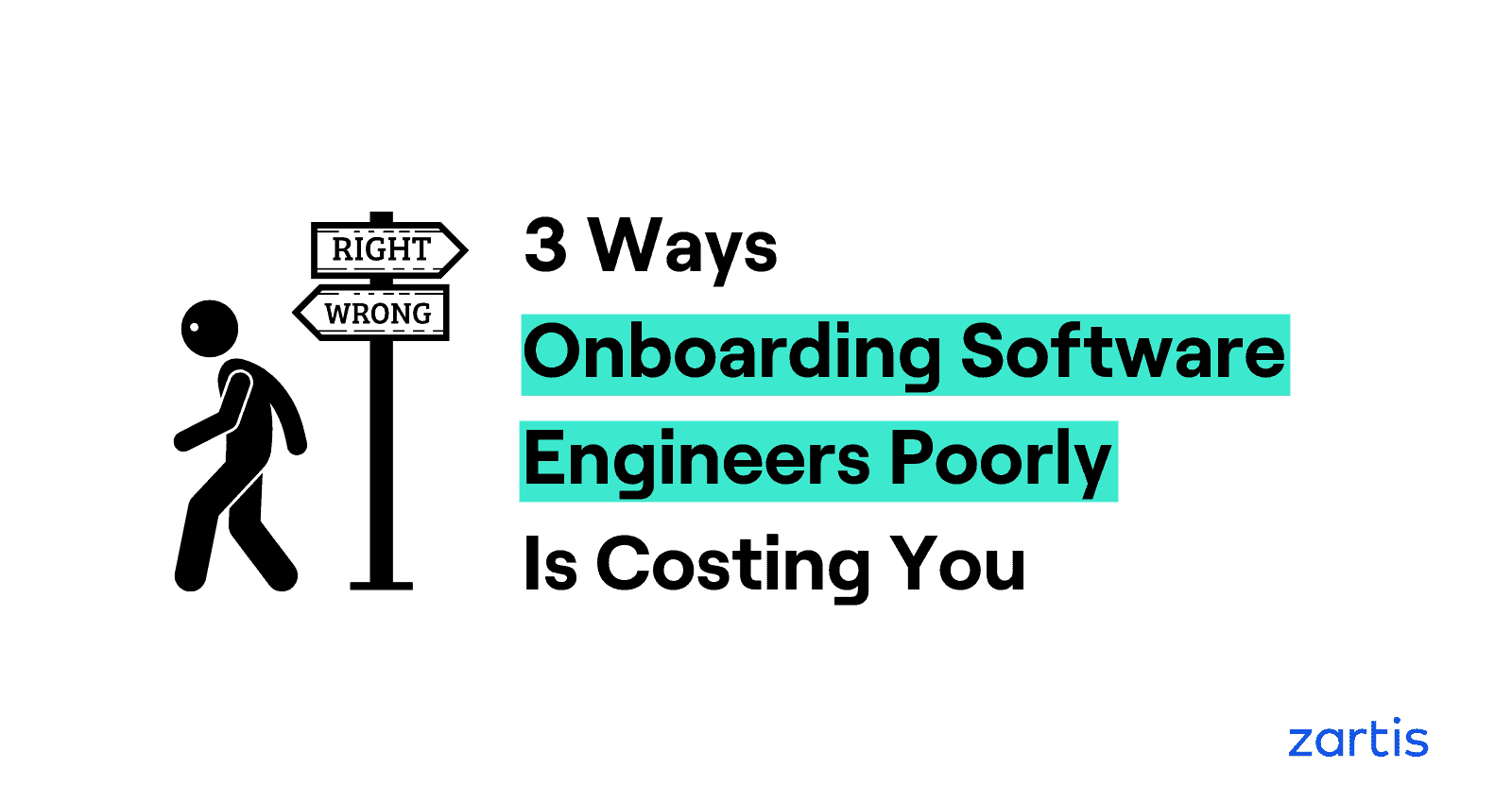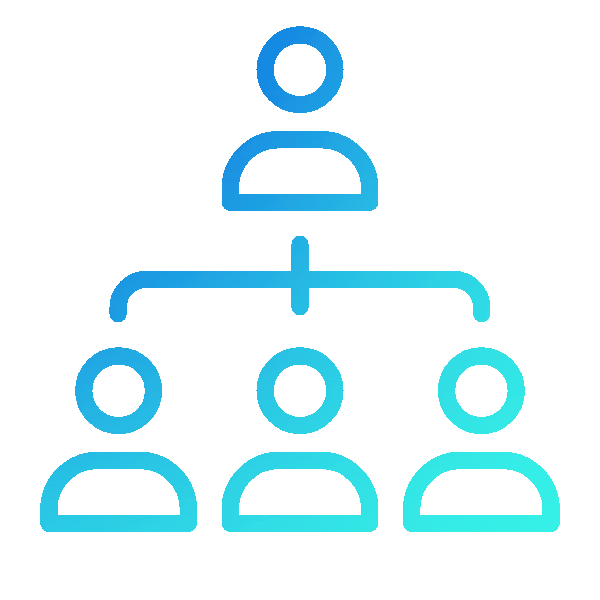So, you’ve finally assembled a stellar team of software developers. Don’t be quick to pat yourself on the back just yet. Hiring talented employees is only half the work – the real challenge is retaining them. And your chances are pretty slim if you don’t know how to onboard software engineers.
Onboarding software engineers poorly results in lower employee morale and engagement, reduced productivity, and high turnover rates. In contrast, a well-thought-out onboarding plan significantly increases new hire retention, workplace efficiency, and overall return on investment.
For more details on the negative effects of subpar onboarding, scroll down. And if you make it to the end of the post, you will also learn our best practices for onboarding engineers.
1. Lower Developer Engagement
What do recruiting software engineers and dating have in common? A lot more than you’d think.
You don’t just woo the person you like once and get to have them by your side forever. You have to show up for them consistently, or there won’t be other dates.
The same applies to recruiting software engineers. As soon as your new prospective technology hire walks through the door, it is not only them that are on trial — so are you and your entire team. And if you don’t know how to keep software developers happy, they will leave for greener pastures.
A high-quality software engineering onboarding process is essential for new team members to feel engaged. And yet, in this study of 350+ organizations, Kronos and the Human Capital Institute found that nearly a quarter of companies had no onboarding process at all. What’s more, a whopping 76% of the surveyed HR professionals thought their organizations underutilized onboarding.
If you, too, don’t have an onboarding process in place, don’t have the time to implement it, or don’t believe that it’s even necessary, you might want to think twice.
According to this 2001 study by the Aberdeen Group, organizations with a standardized onboarding process reported a two-fold increase in new hire engagement.
Why should that matter to you?
Because lower engagement levels result in reduced morale, increased stress, and a lack of trust among developers.
Furthermore, according to Gallup, disengaged staff are 37% more likely to be absent and have 15% lower profitability. Overall, you are looking at losing some $3,400 for every $10,000 your disengaged employees make!
2. Reduced Productivity
New tech hires need around eight months to hit maximum productivity. That’s bad news considering 23% of them quit within their first year on the job, according to this Harvard Business Review study.
However, most ex-employees leave for reasons that could have been addressed at the onboarding stage. In most cases, that involves providing more effective training, clearer guidelines, and a friendlier environment. In fact, the Aberdeen Group found that standard onboarding leads to a 54% increase in new hire productivity.
Even if your new staff doesn’t quit, onboarding is still vital. We’ve already established that poor onboarding results in disengagement, and according to the Gallup study above, disengaged employees are 18% less productive.
Subpar or nonexistent onboarding is also linked to higher stress levels among employees. Your new software engineers will be anxiously struggling to find their way around and process all the information that was — or wasn’t — thrown at them.
The result? One million U.S. workers miss work each day due to stress. For businesses, that translates to an annual loss of around $602 per employee.
3. Lower Retention Rates Among Developers
The above-mentioned Harvard Business Review study also found that, in the general employee population, nearly 33% of new hires begin hunting for new jobs within six months.
That’s a problem.
As an employer, high turnover, especially with software engineers, is the last thing you want. You don’t need us telling you it takes a lot more time and money to hire new software developers than to keep them. The typical cost of turnover in the U.S. is 21% of an employee’s annual salary. That figure can get much higher when it comes to jobs that require highly specific skills — like senior systems architects, lead engineers, or full stack developers.
The good news?
According to this 2015 report by Glassdoor, organizations with a strong onboarding protocol increased their new hire retention by a staggering 82%!
The Advantages of Onboarding Software Engineers Properly
How long does it take to onboard a software developer?
Actually, that’s not the question you should be asking.
To say that every hour you invest in your software developer onboarding process will pay off is an understatement.
A high-quality software engineering onboarding process:
- Attracts talented software engineers
- Helps to keep them around
- Ensures new tech employees have everything they need to become top performers from day one
- Builds rapport between new and old staff
- Improves communication between software engineers and management
- Engages new hires and aligns them with the company’s mission and culture
How to Onboard Software Developers
A typical onboarding program lasts about a week. However, for best results, you want to dedicate a good three months to the process. After that, you should check in on your software engineers and provide follow-up training and support throughout their employment.
Here is how to create a good onboarding process for software engineers:
1. Introduce Them to Your Technical Environment
See that your new hires have all the hardware and software licenses they might need. You also want to ensure they are familiar with the full range of technologies they will be using, as well as the documentation, code review and deployment process you have in place.
Ensure they have access to all required resources with accounts created for every system or product that is required for them to be fully productive. These might need to be requested in advance, so plan ahead.
Also, don’t forget to go over the specific work methodology your development teams are following. Is it Agile or Waterfall? Scrum or Kanban? Do you have stand-ups, and if so, how often and in what format?
2. Outline the Action Plan
First, make sure your new tech employees understand each and every responsibility in their job description. Then, let your software engineers know what you want them to achieve within their first week, month, and quarter on the job. Always set objectives that are specific, measurable, realistic, and time bound.
3. Get Clear on the Constraints
Whether they are constrained by a budget or need to request approval for specific tasks or decisions, all employees must know exactly where their limits lie.
4. Explain the Communication Channels
Your new software engineers need to know how — and when — they can reach everyone in the organization. You should also let them know when and how to report on their work, if there are any meetings they should attend etc.
Last but not least, make sure they are up to speed with any communications tools your organization is using, e.g., Slack, Zoom, Microsoft Teams, GitHub etc.
5. Introduce the Team
Introduce new hires to all other staff members, not just the engineering team. Let them know what their names are and what it is that they do. More importantly, make sure that they have met everyone they would be directly working with to fulfill their daily duties.
Ensure that all relevant team meetings are now going to include the new team members – this might be as easy as forwarding some Calendar invites or inviting them to Slack channels.
6. Explain the Company Culture
New team members should know what the values of the organization are and what behaviors will not be tolerated. Explaining the team culture early on will give your new staff a good idea of what to expect and will also help them internalize the company ethos.
7. Paint the Big Picture
Explain the company’s mission, strategy, and broader goals, as well as how the new employee’s role fits into the larger scheme. Don’t forget to discuss the financial side of things, including company funding, your business model and sales.
8. Talk About Their Career Progression
It is also important to discuss your new employee’s career path and their vision for the future. Are they hoping to land a managerial position one day? Learn a new code base, software architecture, or programming language? Would they like to become a Product Manager, Tech Lead, CTO or start their own business? You want to commit to providing your software engineers with opportunities to achieve their long-term goals.
9. Provide One-On-One Mentoring
If possible, provide new hires with personal mentors to guide them and to also track their progress.
Bonus Tip #1: Do Not Conflate Orientation with Onboarding
Orientation is about helping your new software developers find their way around the building and their workstation and getting up to speed with the office rules and any paperwork. While an orientation program is critical in its own right, it is not a substitute for comprehensive onboarding.
Bonus Tip #2: Consider Automating the Onboarding Process
The more technology you incorporate into your onboarding, the better. Not only does that speed things up, but it also makes it possible to collect and process information systematically. That allows you to standardize the onboarding experience, analyze data in real time, and continuously streamline the process.
How to Onboard Software Engineers: Final Thoughts
One of the top expert tips on how to retain software developers is to invest in a foolproof onboarding process. Create a detailed new developer onboarding checklist and update it regularly. The time and resources you invest in onboarding software engineers will pay off.
At Zartis, we onboard software developers and sometimes whole extended software teams for our clients, functioning as well-integrated members of their in-house software teams. We have long years of experience under our belt building and managing remote engineering teams. Whether you are looking to grow your team internally or outsource development reach out and together, we will come up with a plan to help you achieve your goals without compromising on culture and quality,





